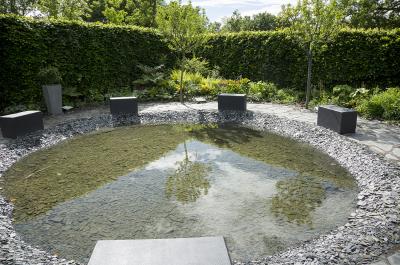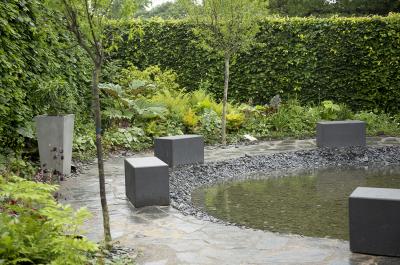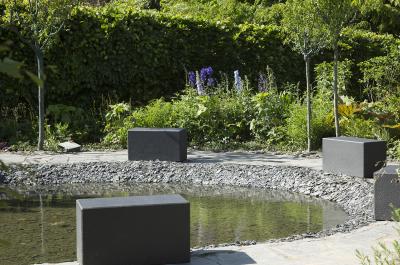05. LES SEPT PÊCHERS CAPITAUX
The garden is a contemporary evocation of the myth of Thomas Aquinas, who conceived the idea of the deadly sins, and who used humour and intelligence to play on the word “péché” (“sin”), perhaps a mortal one, and “pêcher” (“peach tree”), the fruit tree.

To enter the garden is to attempt the experiment of introspection. One advances along the dark, smooth road of life in the form of a disc around a calm, very beautiful central pond, mirror of the soul; it invites us to look right into the depths of our own being.
Turn by turn, we discover the perfect reflections of seven trees, each different but of the same species, and which represent the seven deadly sins: pride, greed, envy, anger, sloth, lust, and gluttony. In the time taken to complete the walk, calmly, we take – for once – the time to reflect on the excesses of humankind.
DESIGNERS

From left to right: Gaël Brulé, François Lepeytre, Julien Douesnard and Franck Cazenave
Gaël Brulé is a sustainable development engineer with a double degree from INSA/KTH (Sweden). He worked for two years as a consultant at Altran Pays-Bas, on a range of themes (transport, investment and sustainable buildings) and at BIO Intelligence Service in Paris for the European Commission. Co-manager of Atelier CMJN, he now develops his HEQ skills gained working at previous design firms; he guides project managers and contractors in their certification processes and injects his significant environmental expertise, which is constantly updated, into architectural projects. With a concern for ongoing development, he co-writes articles on sustainable architecture for "Cyberarchi". Lastly, he writes scientific chapters and articles on the sociology of well being and is the director of the scientific committee of Fabrique Spinoza, a "think tank" promoting public well being.
After graduating in 2008, François Lepeytre quickly joined the leading French architecture firms in the field of sustainable development in order to learn about the methods and techniques of environmentally responsible architecture. These skills fitted well in the Atelier CMJN project highlighting the relationship between the landscape and architecture. Together with Gaël Brulé, he commenced theoretical work on sustainable architecture and contributed to the site "Cyberarchi" and the magazine "À vivre". This attraction to the materiality of a project and the conviction and architecture and landscape must be intrinsically linked were the driving forces of his undergoing training, as of 2012, in landscape architecture, which he does at the same time as carrying out the agency's landscaping projects currently underway.
After his career as an environmental engineer with the Rouen INSA, Julien Douesnard decided to change direction and go down the path of landscape architecture. In order to do this, he enrolled in the Versailles ENSP (École Nationale Supérieure de Paysage) to undergo training to become a landscape designer. He then practiced in various landscaping firms, mainly in Paris, all the time continuing to develop his own projects. He notably spent some time in Denmark, in order to gain knowledge on permaculture. Far from abandoning his engineering roots - on the contrary - he tries, for each planning project, to reconcile aesthetic, ecological and functional aspects - a complementary approach which is essential to the creation of spaces adapted to their context.
From 2002 to 2008, Franck Cazenave was head of the "Fountains / urban planning" department for the Eiffage-Forclum group, with whom he won the 1st international prize in 2007 for the entirety of his research, including the "Phylléas Wall", a plant wall to reduce energy costs from air conditioning. With several international ONGs, he developed the construction of "new generation" wells, integrating an element of public health, which still serve as a reference today. Since 2008 he has managed a firm specialised in engineering and project management of fountains and natural aquatic pools, for which he implements pioneering methods inspired by quantum physics. He is behind many patents, designs and models to do with water. He teaches training courses on the management of natural aquatic.


